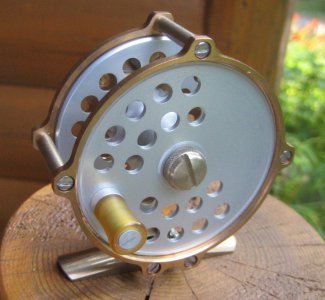- Joined
- Oct 8, 2015
- Messages
- 10
I have been making fly reels by manual operation of a mill and lathe, and am trying to decide if CNC would also work.
As a new member, it appears that I cannot insert a photo here (because it might be spam?). But look at my Avatar for an aluminum frame reel, or click on the attached image file to see a bronze frame reel.
Consider the front end ring. It is a thin ring that is supported by several lugs. I cut the arcs between the lugs with my mill and a rotary table. The finish is smooth enough that the part only requires tumbling in stainless steel media to finish.
If I made this part on a CNC mill or router with X, Y, and Z axes, and used the appropriate G code to cut the arcs, could I achieve the same finish? Or would a rotary table still be needed?

As a new member, it appears that I cannot insert a photo here (because it might be spam?). But look at my Avatar for an aluminum frame reel, or click on the attached image file to see a bronze frame reel.
Consider the front end ring. It is a thin ring that is supported by several lugs. I cut the arcs between the lugs with my mill and a rotary table. The finish is smooth enough that the part only requires tumbling in stainless steel media to finish.
If I made this part on a CNC mill or router with X, Y, and Z axes, and used the appropriate G code to cut the arcs, could I achieve the same finish? Or would a rotary table still be needed?


